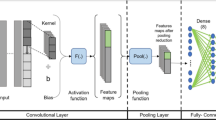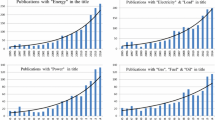Abstract
Short-term load forecasting with high accuracy is essential to power systems. Because power loads involve high volatility and uncertainty, it is challenging to accurately perform short-term load forecasting (STLF). To solve this problem, this paper proposes a decomposition-based approximate entropy cooperation long short-term memory (DB-AEC-LSTM) model for STLF. In DB-AEC-LSTM, a complete ensemble empirical mode decomposition with adaptive noise (CEEMDAN) method is first introduced to generate the multiple electric load time series into many cooperation sub-series and decrease the reconstruction errors. Then, an Approximate Entropy Cooperation ensemble Long Short-term Memory Model is developed by using approximate entropy (ApEn) to construct an effective cooperative relationship between different time sub-series groups, greatly improving the predictive accuracy. By rationally combined the effective technologies ApEn, CEEMDAN, and AEC-LSTM, the proposed DB-AEC-LSTM can obtain competitive predictive performance in STLF. Several short-term load forecasting datasets are performed to check the predictive performance of DB-AEC-LSTM. Experimental results show that DB-AEC-LSTM has better predictive accuracy and satisfactory robustness compared with state-of-the-art and conventional predictive models.





Similar content being viewed by others
Abbreviations
- STLF:
-
Short-term load forecasting
- LSTM:
-
Long short-term memory
- CEEMDAN:
-
Complete ensemble empirical mode decomposition with adaptive noise
- ApEn:
-
Approximate entropy
- DB-AEC-LSTM:
-
Decomposition-based approximate entropy cooperation long short-term memory model
- CG:
-
Cooperation group
- EMD:
-
Empirical mode decomposition
- EEMD:
-
Ensemble empirical mode decomposition
- IMF:
-
Intrinsic mode function
- Res:
-
Residual
- RVFL:
-
Random vector functional link
- e s :
-
Ensemble size in the CEEMDAN method
- \({w}_{k}\) :
-
White noise with (0, 1) in CEEMDAN
- \(r\) :
-
Tolerance parameter in ApEn
- \(k\) :
-
Correlation dimension parameter
- n h1 :
-
Total number of hidden units in AEC-LSTM
- w d :
-
Weight of dropout in AEC-LSTM
- lr:
-
Learning rate of AEC-LSTM
- \(L(t)\) :
-
Original electric load time-series data
- \(\overline{{\mathrm{IMF}}_{j}}\left(t\right)\) :
-
jTh-order IMFs obtained by CEEMDAN
- \(\mathrm{Res}\left(t\right)\) :
-
Final decomposed residue
- \({\mathrm{AE}}_{j}\) :
-
ApEn coefficient for different IMFs
- \({\mathrm{PIMF}}_{j}\) :
-
Prediction result for different IMFs
- b c :
-
Bias matrix for cell block
- b F :
-
Bias matrix for forget gate
- b I :
-
Bias matrix for input gate
- b O :
-
Bias matrix for output gate
- \({S}_{j}\)(t):
-
External input data
- \(C\left(t\right)\) :
-
Data matrix of cell block at time t
- \(F\left(t\right)\) :
-
Data matrix of forget block at time t
- \(I\left(t\right)\) :
-
Data matrix of input block at time t
- \(O\left(t\right)\) :
-
Data matrix of output block at time t
- \({\mathrm{Node}}_{\eta }\) :
-
Node of hidden layer expanded in time sequence
- \({w}_{\mathrm{C}}\) :
-
Weight matrix for cell block
- \({w}_{\mathrm{F}}\) :
-
Weight matrix for forget gate
- \({w}_{\mathrm{I}}\) :
-
Weight matrix for input gate
- \({w}_{\mathrm{O}}\) :
-
Weight matrix for output gate
References
Dinesh C, Makonin S, Bajić IV (2019) Residential power forecasting using load identification and graph spectral clustering. IEEE Trans Circuits Syst II Exp Pap 66(11):1900–1904
Raza MQ, Khosravi AJR, Reviews SE (2015) A review on artificial intelligence-based load demand forecasting techniques for smart grid and buildings. Renew Sustain Energy Rev 50:1352–1372
Salkuti SR (2018) Short-term electrical load forecasting using radial basis function neural networks considering weather factors. Electr Eng 100:1985–1995
Tu H, Xia Y, Iu HH, Chen X (2019) Optimal robustness in power grids from a network science perspective. IEEE Trans Circuits Syst II Exp Pap 66(1):126–130
Zhou M, Jin M (2019) Holographic ensemble forecasting method for short-term power load. IEEE Trans Smart Grid 10(1):425–434
Dosiek L (2020) The effects of forced oscillation frequency estimation error on the LS-ARMAS mode meter. IEEE Trans Power Syst 35(2):1650–1652
Ertuğrul ÖF, Tekin H, Tekin R (2021) A novel regression method in forecasting short-term grid electricity load in buildings that were connected to the smart grid. Electr Eng 103:717–728
Jian-an Z, Yun-bing W, Cheng-cheng J, Cheng-ming Z (2020) Short-term load forecasting model of gray-weighted markov chain based on particle swarm optimization. In: Asia energy and power engineering symposium conference, Chengdu, China, pp 825–830
Munawar U, Wang Z (2020) A framework of using machine learning approaches for short-term solar power forecasting. J Electr Eng Technol 15:561–569
Kwon BS, Park RJ, Song KB (2020) Short-term load forecasting based on deep neural networks using LSTM layer. J Electr Eng Technol 15:1501–1509
Ren Y, Suganthan PN, Srikanth N (2016) Random vector functional link network for short-term electricity load demand forecasting. Inf Sci 367:1078–1093
Dedinec A, Filiposka S, Dedinec A (2016) Deep belief network based electricity load forecasting: an analysis of Macedonian case. Energy 115:1688–1700
Chen CLP, Liu Z (2018) Broad learning system: an effective and efficient incremental learning system without the need for deep architecture. IEEE Trans Neural Netw Learn Syst 29(1):10–24
Sina A, Kaur D (2020) Short term load forecasting model based on kernel-support vector regression with social spider optimization algorithm. J Electr Eng Technol 15:393–402
Ruxue L, Shumin L, Miaona Y (2021) Load forecasting based on weighted grey relational degree and improved ABC-SVM. J Electr Eng Technol
Lahouar A, Slama JBH (2015) Random forests model for one day ahead load forecasting. In: International renewable energy congress, Sousse, pp 1–6
Singh S, Hussain S, Bazaz MA (2017) Short term load forecasting using artificial neural network. In: Fourth international conference on image information processing (ICIIP), pp 1–5
Zhang R, Dong ZY, Xu Y (2013) Short-term load forecasting of Australian National Electricity Market by an ensemble model of extreme learning machine. IET Gener Transm Distrib 7(4):391–397
Qiu X, Ren Y, Suganthan PN (2017) Empirical mode decomposition based ensemble deep learning for load demand time series forecasting. Appl Soft Comput 54:246–255
Qiu X, Suganthan PN, Amaratunga GAJ (2018) Ensemble incremental learning random vector functional link network for short-term electric load forecasting. Knowl-Based Syst 145:182–196
Yang Y, Yang Y (2020) Hybrid method for short-term time series forecasting based on EEMD. IEEE Access 8:61915–61928
Salkuti SR (2018) Short-term electrical load forecasting using hybrid ANN–DE and wavelet transforms approach. Electr Eng 100:2755–2763
Salami M, Sobhani FM, Ghazizadeh MS (2020) A hybrid short-term load forecasting model developed by factor and feature selection algorithms using improved grasshopper optimization algorithm and principal component analysis. Electr Eng 102:437–460
Haben S, Singleton C, Grindrod P (2016) Analysis and clustering of residential customers energy behavioral demand using smart meter data. IEEE Trans Smart Grid 7(1):136–144
Jahangir H, Tayarani H, Gougheri SS, Golkar MA, Ahmadian A, Elkamel A (2020) Deep learning-based forecasting approach in smart grids with micro-clustering and bi-directional LSTM network. IEEE Trans Ind Electron, pp 1–1
Zhang C, Li R (2021) A novel closed-loop clustering algorithm for hierarchical load forecasting. IEEE Trans Smart Grid 12(1):432–441
Yue Y, Zhao Y, Zhao H, WangH (2017) Short-term wind speed combined prediction for wind farms. In: IEEE international conference on mechatronics and automation (ICMA), pp 18–22
Dong P et al (2019) Short-term load forecasting based on EEMD-approximate entropy and ELM. In: 2019 IEEE Sustainable power and energy conference (iSPEC), pp 1772–1775
Ruiz-Aguilar JJ, Turias I, González-Enrique J, Urda D, Elizondo D (2021) A permutation entropy-based EMD–ANN forecasting ensemble approach for wind speed prediction. Neural Comput Appl 33(7):2369–2391
Li W, Shi Q, Sibtain M, Li D, Mbanze DE (2021) A hybrid forecasting model for short-term power load based on sample entropy, two-phase decomposition and whale algorithm optimized support vector regression. IEEE Access 8:166907–166921
Torres ME, Colominas MA, Schlotthauer G et al (2011) A complete ensemble empirical mode decomposition with adaptive noise. In: IEEE international conference on acoustics, speech and signal processing (ICASSP), Prague, pp 4144–4147
Huang NE, Shen Z, Long SR et al (1998) The empirical mode decomposition and the Hilbert spectrum for nonlinear and non-stationary time series analysis. Proc R Soc A Math Phys Eng Sci 454(1971):903–995
Wu Z, Huang NE (2009) Ensemble empirical mode decomposition: a noise-assisted data analysis method. Adv Adapt Data Anal 1(1):1–41
Pincus SM (1911) Approximate entropy as a measure of system complexity. 88(6):2297–2301
Neeraj N, Mathew J, Agarwal M et al (2021) Long short-term memory-singular spectrum analysis-based model for electric load forecasting. Electr Eng 103:1067–1082
Hochreiter S, Schmidhuber J (1997) Long short-term memory. Neural Comput 9(8):1735–1780
Chen Z, Zhang D, Jiang H et al (2021) Load forecasting based on LSTM neural network and applicable to loads of replacement of coal with electricity. J Electr Eng Technol
‘Australian energy market operator (Dec. 2016). http://www.aemo.com.au/. Accessed 27 Nov 2020
Chen CLP, Liu Z et al (2018) Broad learning system: an effective and efficient incremental learning system without the need for deep architecture. IEEE Trans Neural Netw Learn Syst 29(1):10–24
Acknowledgements
This work was supported in part by the National Natural Science Foundation of China under Grants 61863028, 81660299, and 61503177, and in part by the Science and Technology Department of Jiangxi Province of China under Grants 20204ABC03A39, 20161ACB21007, 20171BBE50071, and 20171BAB202033.
Author information
Authors and Affiliations
Corresponding author
Additional information
Publisher's Note
Springer Nature remains neutral with regard to jurisdictional claims in published maps and institutional affiliations.
Rights and permissions
About this article
Cite this article
Huang, J., Li, C., Huang, Z. et al. A decomposition-based approximate entropy cooperation long short-term memory ensemble model for short-term load forecasting. Electr Eng 104, 1515–1525 (2022). https://doi.org/10.1007/s00202-021-01389-0
Received:
Accepted:
Published:
Issue Date:
DOI: https://doi.org/10.1007/s00202-021-01389-0




